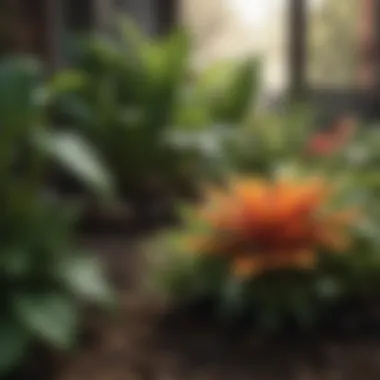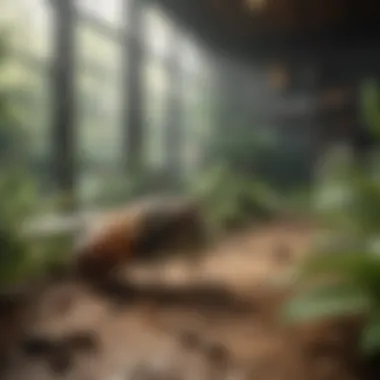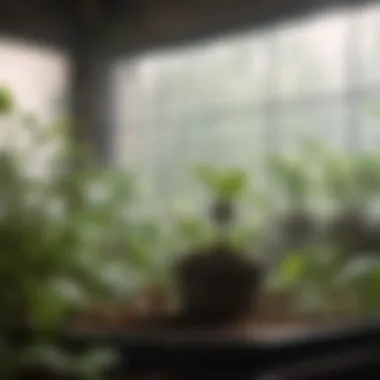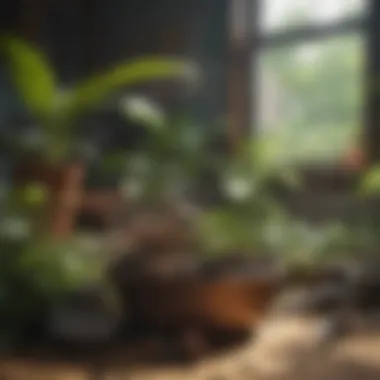Effective Strategies to Eliminate Plant Flies


Intro
Flies can be a persistent issue for those who nurture plants, whether in gardens or indoor settings. The presence of these pests not only disrupts the growth process but can also lead to serious damage to delicate foliage. Understanding how best to manage and eliminate flies from plants is crucial for maintaining a healthy ecosystem.
This guide examines various strategies aimed at controlling fly populations effectively. From preventive tactics to natural solutions, the steps outlined here cater specifically to homeowners and gardening enthusiasts intent on fostering a flourishing plant environment. By adopting a comprehensive approach that considers both ecological impacts and practical implementations, you will be better equipped to safeguard your plants against these nuisances.
To navigate through the complexities of this problem, we will analyze different categories of interventions, highlighting their importance, implementation strategies, and overall effectiveness. It's essential to formulate a plan that reflects an understanding of the underlying causes for fly infestations and the subsequent solutions available.
Design Inspirations
While the main focus is on managing flies, creating an inviting and functional garden or plant space can also contribute to healthy growing conditions. The aesthetics of a garden can play a role in pest management as well. Let's consider how to make your plant area both beautiful and functionally effective in deterring flies.
Trending Styles
Increasingly, naturalistic designs in gardening are gaining popularity. Emphasizing native plants not only ensures a rich ecosystem but also reduces the likelihood of pest attraction. Incorporating various layers of plants can mimic natural habitats, providing benefits such as increased biodiversity.
Color Palettes
Selecting the right colors for your garden can also impact its appeal and functionality. Consider using a range of greens combined with pops of bright, floral colors. This combination can attract beneficial insects while potentially distracting pest flies from your plants.
Maintenance and Upkeep
Keeping your garden or indoor plants well-maintained is vital in controlling fly populations. Regular maintenance practices can create an unwelcoming environment for flies, allowing your plants to thrive undisturbed.
Seasonal Maintenance Checklist
Here’s a brief checklist to consider each season:
- Spring: Inspect soil quality, replace any dead or sick plants.
- Summer: Water consistently but avoid puddles; remove any overripe fruits.
- Fall: Clean up fallen leaves and debris; consider planting cover crops.
- Winter: Ensure protective coverings for perennials and inspect indoor plants for any signs of flies.
Cleaning and Organization Tips
Keeping your plant area clean and organized is crucial. Here are some practical tips:
- Regularly remove dead plant material and debris.
- Use containers that allow for good drainage.
- Store gardening tools away from plants to minimize mess and pest attraction.
This structured approach to plant management not only improves aesthetic appeal but also enhances pest control, specifically regarding flies.
"A well-maintained garden is the first line of defense against plant pests, including flies. Regular care and organization can greatly reduce infestations."
Intro to Fly Infestations
The issue of fly infestations in gardening is a critical concern that demands attention. Understanding these infestations is more than just recognizing the presence of flies; it encompasses grasping their lifecycle, behaviors, and the specific threats they pose to plants. This knowledge can lead to more effective control measures, ensuring the health and longevity of plants in various settings, from home gardens to professional landscaping.
Understanding Fly Species
Different fly species have distinct life cycles and behaviors that affect their interaction with plants. Common culprits include the fungus gnat, which is notorious for its larvae damaging plant roots, and fruit flies, known for attacking overripe or decaying fruits. By identifying the species present, gardeners can tailor their approach to management effectively. For instance, recognizing that fungus gnats thrive in overly moist conditions can lead to adjustments in watering practices.
Furthermore, a thorough understanding of the reproductive behaviors of these flies can provide insights into when and how to implement control measures. Some species reproduce quickly, and their populations can escalate rapidly if not addressed promptly. Strategies can include monitoring techniques, like sticky traps, which help in identifying fly presence before populations become unmanageable.
Common Symptoms of Infestation
Recognizing the signs of fly infestation is essential for timely intervention. Common symptoms include:
- Wilting or yellowing leaves: This often indicates root damage caused by larvae.
- Visible flies hovering over plants: Adult flies may be seen around the affected plants, a clear indicator of infestation.
- Small holes in leaves or fruits: This is particularly notable with fruit flies and can lead to further decay.
- Fungal growth or mold: Especially from fungus gnats, often found in the soil of overwatered plants.
By knowing these symptoms, gardeners can take immediate action to mitigate damage. Early identification not only saves the current plants but also prevents future infestations.
"Prevention is always better than cure; understanding fly species and their symptoms leads to proactive management of infestations."


In summary, an appreciation of fly infestations begins with recognizing the various fly species and the symptoms they cause. This foundational knowledge is critical to developing comprehensive strategies that safeguard plant health, making it an essential part of effective pest management.
The Importance of Pest Management
Pest management is critical when it comes to maintaining healthy plants. Flies, often underestimated as mere nuisances, can cause significant harm if left unchecked. Understanding pest management enables gardeners to proactively guard their plants against infestations, preserving both the aesthetic appeal and the overall health of their greens.
Effective pest management entails identifying and addressing pest problems before they escalate. This approach is essential as flies can transmit diseases, lead to deterioration in plant vigor, and create an unsuitable environment for growth. A well-thought-out pest management strategy reduces the dependency on harsh chemicals, promoting a healthier ecosystem.
Moreover, pest management is not merely reactive but a continuous process. It involves monitoring pest populations, determining thresholds for action, and implementing cultural, biological, and chemical controls. Such a holistic view leads to more sustainable gardening practices, which benefit not only the plants but also the environment.
Impact on Plant Health
The health of plants is intricately linked to their ability to fend off pests. When flies invade, they can damage foliage, stems, and roots. This damage can present as wilting, discoloration, or even death of the plant. For example, the presence of certain fly species can lead to the transmission of plant viruses, which can ravage entire crops. Regular pest management helps to keep these threats in check, ensuring plants remain robust and vibrant.
Additionally, healthy plants can outcompete pests for resources, reducing the likelihood of infestation. This emphasizes the importance of continuous vigilance and maintenance in any gardening endeavor. Practices like proper watering, soil management, and adequate spacing can foster a thriving plant environment where pests have a harder time establishing.
The Economic Cost of Fly Infestations
Fly infestations carry significant economic implications. Homeowners and commercial growers face losses due to reduced crop yields and increased expenditure on pest control methods. The financial burdens can escalate quickly, especially if infestations are not caught early. The costs can arise from direct damage to plants or indirect effects like the need for more intensive pest management strategies.
According to various studies, crop damage caused by flies can lead to losses in the millions for large-scale agricultural operations. These economic factors spotlight the necessity of an effective pest management program. In addition to lessening direct costs, investing in pest management helps protect future investments in gardening or farming.
"Proactive pest management not only keeps plants healthy but also ensures economic sustainability for any gardening endeavor."
Preventive Measures Against Flies
Preventive measures are essential in managing fly populations and ensuring that plants thrive without the threat of pests. A proactive approach reduces the risk of infestations, thus maintaining the health of the garden. Implementing these measures can save time and resources, creating a more enjoyable gardening experience. Effective strategies not only protect plant integrity but also contribute to a sustainable environment.
Cultural Practices
Cultural practices form a foundational element of preventative measures against flies. These strategies optimize growing conditions while limiting the pests’ potential impact.
Proper Watering Techniques
Proper watering techniques are vital to plant health and can significantly reduce fly problems. Overwatering can lead to soil saturation, promoting conditions that entice pests. An important aspect of this technique is to water in the early morning. This helps plants absorb moisture and reduces standing water that flies can use for breeding.
Key characteristics of proper watering include providing sufficient moisture without creating excess water pooling. This approach is beneficial because it encourages strong root systems and healthy foliage, making plants less susceptible to fly infestations.
However, it requires careful monitoring of soil moisture levels. Too little water can stress the plants, while too much can encourage flies and other pests.
Crop Rotation Strategies
Crop rotation strategies are another effective method to manage flies in the garden. This technique involves alternating the types of crops grown in a specific area. The primary contribution of crop rotation lies in disrupting pest life cycles. For example, rotating plants can reduce populations of flies that target specific crops.
The key characteristic of this strategy is its ability to break pest habits. It is a beneficial choice because it not only protects plants from flies but also enhances soil health. Different plants contribute various nutrients back to the soil, fostering a robust ecosystem.
The unique feature of crop rotation is its ability to be tailored to specific plants and pests. Nevertheless, it requires careful planning and knowledge of which crops are compatible and beneficial at different times of the year.
Sanitation Practices
Sanitation practices are critical in preventing fly infestations. Keeping garden areas clean removes potential breeding sites for flies. This includes regularly clearing debris, fallen fruits, and wilted leaves that can attract pests.
Additionally, maintaining clean tools and containers used in the garden minimizes the risk of transferring pests between plants. Proper disposal of organic waste can also deter flies from establishing a presence.
It is important to recognize that consistent sanitation enhances the overall health of plants. Creating a routine for waste removal and garden clean-up can serve as a strong line of defense against flies. Regular monitoring and a clean environment significantly contribute to protecting plants from infestation.
Natural Remedies for Fly Control
Natural remedies play a significant role in managing fly infestations in plants. They often use readily available ingredients and methods that are environmentally friendly. Understanding these remedies is crucial for gardening enthusiasts who seek alternatives to chemical pesticides. Natural remedies not only help control flies effectively but also contribute to a healthier ecosystem.
Many homeowners appreciate these options because they avoid exposure to harsh chemicals. Furthermore, these methods can be cost-effective. They offer an approachable starting point for fly control. With the right knowledge and application, these remedies can significantly reduce fly populations while maintaining plant health.


Homemade Solutions
Homemade solutions are an effective way to combat flies without using synthetic products. They allow for personalization based on individual garden needs.
Soap and Water Spray
Soap and water spray is a simple yet effective method for controlling flies on plants. This solution works by suffocating the flies, disrupting their ability to breathe. The key characteristic of this method is its gentle formulation. It poses minimal risk to plants while targeting pests.
This solution is a popular choice in organic gardening due to its non-toxic nature. The unique feature of soap and water spray lies in its accessibility. Most households already have soap available. However, it is vital to use a mild soap to prevent damage to sensitive plants.
The advantages include ease of preparation and the lack of harmful chemicals. However, over-application could lead to foam buildup, which may harm the plant. Therefore, it is advisable to apply during cooler parts of the day to reduce stress on plants.
Vinegar Traps
Vinegar traps are another effective homemade solution for managing flies. The specific aspect of vinegar traps is their attraction to the smell of vinegar combined with sugar or fruit. This combination draws flies, leading them into a trap.
Vinegar traps are popular because they are inexpensive and straightforward to deploy. The unique feature is the ability to use common kitchen ingredients, making them accessible for many gardeners.
The primary advantage of vinegar traps is effectiveness in controlling fruit flies without chemicals. However, they might require regular maintenance and replenishment, as the traps can become saturated or lose effectiveness over time.
Beneficial Insects
Introducing beneficial insects is a holistic approach to fly control. These insects naturally predate on harmful flies, helping manage populations balance in an ecologically sound way.
Introducing Predators
Introducing predators, such as ladybugs and lacewings, is an effective strategy. These insects feed on pests, including flies. The key characteristic of introducing predators is their natural hunting behavior, which contributes to reducing pest populations.
This method is beneficial because it encourages biodiversity within the garden. It creates a self-sustaining environment, making it easier to maintain plant health. One downside could be that it requires patience, as results may take longer to become visible. Proper research on compatible species is also necessary for successful implementation.
Companion Planting Techniques
Companion planting techniques involve growing certain plants together to deter pests. Specific plants can naturally repel flies or attract predatory insects. This science-backed approach emphasizes ecosystem balance.
A well-known aspect of companion planting is its dual benefit—aesthetic appeal and pest control. The unique feature is the strategic selection of plants that complement each other, benefiting growth patterns and pollination.
The key advantage here lies in creating a natural barrier against flies. However, careful planning is required to ensure that companion plants thrive together. If not planned effectively, it could lead to competition for resources.
Natural remedies, combined with awareness of beneficial insects, create a robust strategy against fly infestations in gardens.
By considering homemade solutions and beneficial insects, gardeners can effectively manage fly problems. These methods not only safeguard plants but also support a healthier growing environment.
Chemical Solutions for Fly Infestation
Chemical solutions play a crucial role in managing fly infestations in plants. When preventive measures and natural remedies fail to yield satisfactory results, pesticides and insecticides become essential tools. These chemical agents target flies effectively while minimizing harm to the plants and surrounding ecosystem. However, it's vital to understand their proper use, benefits, and potential risks. This balance will ensure healthy plant environments without compromising safety for humans and beneficial organisms.
Pesticides and Insecticides
Pesticides are substances used to kill pests, including flies that pose a threat to plants. Insecticides, a subset of pesticides, are specifically designed to target insects. These products come in various forms, including sprays, granules, and bait traps. Here are important points regarding their application:
- Selectivity: Choose products targeting the specific fly species affecting your plants. Broad-spectrum pesticides can harm beneficial insects as well.
- Formulation: Liquid sprays usually provide immediate results, while granules may offer longer-term control. Evaluate your needs based on the infestation level.
- Application Timing: Apply during periods when flies are most active, often in warmer months. Early morning or late evening can be optimal times to minimize impact on beneficial insects.
Insecticides, such as imidacloprid or pyrethroids, have proven effective against various fly species. Always refer to the label instructions for proper application rates and methods, ensuring safe usage.
Safety Measures and Guidelines
Using chemical solutions requires adherence to strict safety measures. Misapplication or negligence can lead to unintended consequences, including health risks. Key guidelines include:
- Personal Protection: Wear gloves, masks, and goggles during application to shield yourself from exposure.
- Environmental Considerations: Avoid applying chemicals before rain, as runoff can contaminate nearby water sources. Check local regulations for specific guidelines related to chemical use.
- Storage: Store pesticides in a cool, dry place, away from children and pets. Ensure containers are tightly sealed to prevent spills.
- Follow Instructions: Always read product labels carefully. They contain vital information on dosage, application frequency, and safety protocols.


Proper chemical management not only protects your plants but also safeguards the surrounding ecosystem. Understanding the balance between effective treatment and safety is imperative.
Integrated Pest Management (IPM)
Integrated Pest Management, or IPM, is a holistic approach to controlling pest populations, notably flies that affect plants. Its significance lies in blending various strategies to manage pest problems effectively while minimizing harm to the environment. With rising concerns about chemical pesticide use, IPM offers a balanced alternative that emphasizes sustainability. The multifaceted nature of this approach enables gardeners to address fly infestations without relying solely on chemical interventions.
IPM includes a spectrum of practices, from monitoring pest populations to implementing cultural, physical, biological, and, when necessary, chemical strategies. This framework helps in strategizing interventions that protect plant health and enhance ecosystem integrity. The beauty of IPM is that it considers the broader ecological relations and seeks long-term solutions instead of short-term fixes.
Understanding IPM Principles
The principles of IPM center on preventive measures, accurate pest identification, and monitoring. Here are some key aspects of IPM:
- Preventive Practices: This involves creating an environment less conducive to fly infestation. Proper watering, selecting resistant plant varieties, and rotating crops play a role.
- Regular Monitoring: Keeping a close eye on pest populations enables quicker responses to infestations before they escalate. Techniques such as visual inspections and traps can be effective.
- Control Tactics: This part focuses on the integration of multiple methods for managing flies, including biological controls with natural predators and targeted chemical applications when necessary.
By understanding these IPM principles, gardeners can adapt their practices to reduce fly populations effectively.
Implementing IPM in Home Gardens
The implementation of IPM in home gardens is vital for those aiming for healthy and thriving plants. Here are practical steps to incorporate IPM principles:
- Assessment: Start by identifying fly species that you may encounter in your garden. Understanding their behavior helps in selecting the right management tactics.
- Cultural Controls: Adopt practices like crop rotation or selecting plants that are resistant to specific fly types. Adjust watering schedules to avoid over-irrigation which often attracts pests.
- Physical Controls: Use row covers or traps to disrupt the flies’ life cycle and prevent them from accessing your plants.
- Biological Controls: Introduce beneficial insects such as ladybugs or parasitic wasps, which can help keep fly populations in check.
- Evaluation and Adjustment: Regularly monitor the results of implemented strategies. Be prepared to modify your approach based on what works best for your specific gardening environment.
Implementing IPM not only combats fly issues but also promotes a healthier garden ecosystem. As you adapt these practices, consider the long-term benefits of investing in sustainable pest management strategies.
Monitoring and Evaluation of Fly Control Methods
Monitoring and evaluation are critical components in the strategy to eliminate flies from plants. Regular examination of the effectiveness of applied control methods helps not only in gauging their success but also in informing future decisions. Understanding how well various strategies perform is essential for sustainable pest management. These processes empower gardeners to adapt their approaches based on real-time data, promoting more effective interventions against fly infestations.
Regular Inspections
Implementing a schedule for regular inspections forms the backbone of effective monitoring. By examining plants frequently, any signs of fly activity can be detected early. Homeowners need to look for key indicators such as:
- Adult Flies: Observing the presence of adult flies around plants can indicate an ongoing infestation.
- Eggs and Larvae: Carefully checking the undersides of leaves or within soil can reveal eggs or larvae. This is crucial because treating the infestation at this stage can prevent further escalation.
- Plant Health: Signs of damage such as wilting, discoloration, or nutrient deficiency may also indicate fly problems.
Regular checks not only help in early detection but also in determining the best course of action. By keeping a close eye on plant conditions, one can adjust pest control strategies effectively.
Assessing Effectiveness of Strategies
After implementing control methods, assessing their effectiveness is crucial. This can involve several considerations. Key points to evaluate include:
- Comparative Analysis: Review the health of affected plants before and after applying control measures. A marked improvement suggests effective strategies.
- Fly Population Monitoring: Utilizing sticky traps can help track fly populations over time. This quantitative method provides insight into trends and helps in decision making.
- Adaptation of Strategies: Not all methods work universally. Based on the outcomes observed, adjusting approaches or combining multiple strategies may be necessary to improve results.
"Effective monitoring is a step toward informed decision-making, fostering a sustainable approach to pest control."
Overall, good practices in monitoring and evaluation lend themselves to a more resilient gardening experience. Homeowners and gardening enthusiasts can enjoy healthier plants by continually refining their pest management strategies.
Ending: Achieving Fly-Free Plants
In the pursuit of cultivating healthy and flourishing plants, achieving a fly-free environment is paramount. Fly infestations not only compromise the vitality of plants but can also lead to significant economic losses in agricultural settings. This conclusion section synthesizes the strategies discussed in the article, reinforcing the necessity of a multi-faceted approach to pest management.
The understanding of various methods, from preventive measures to chemical interventions, equips homeowners and gardening enthusiasts with the tools needed to maintain the integrity of their plants. The article emphasizes that no single approach suffices; instead, a combination of methods tailored to specific circumstances yields the best results.
Sustainable Practices for Long-term Solutions
Implementing sustainable practices is critical in the long-term management of fly infestations. These practices not only focus on eliminating flies but also promote ecosystem health. Here are some key strategies:
- Encouraging Biodiversity: A diverse garden ecosystem can deter pests. Selecting a variety of plant species can attract beneficial insects, which help control fly populations.
- Soil Health: Healthy soil contributes to the overall vigor of plants, making them less susceptible to infestations. Regularly amending soil with organic matter can enhance its quality.
- Water Management: Overwatering can create conducive environments for flies. Practicing proper irrigation techniques, such as drip or soaker hoses, minimizes standing water.
Sustainable practices not only address immediate pest issues but also reduce reliance on chemical solutions over time, promoting a healthier growing environment.
The Role of Education in Pest Prevention
Education emerges as a cornerstone in the prevention of fly infestations. Understanding the life cycle of flies and their behaviors empowers gardeners to identify and act quickly upon signs of infestation. Knowledge can be shared in various formats:
- Workshops and Community Programs: Local gardening clubs or agricultural extensions often host educational sessions that inform participants about best practices in pest management.
- Online Resources: Websites such as en.wikipedia.org, britannica.com, and reddit.com offer valuable information and forums for discussion about gardening challenges.
- Regular Updates: Staying informed about new research and trends in pest management can help gardeners apply the most effective and sustainable methods.
Education fosters not just individual awareness, but cultivates a community of informed gardeners who can support and learn from one another. This collective knowledge leads to better outcomes in pest prevention and ultimately contributes to achieving fly-free plants.







